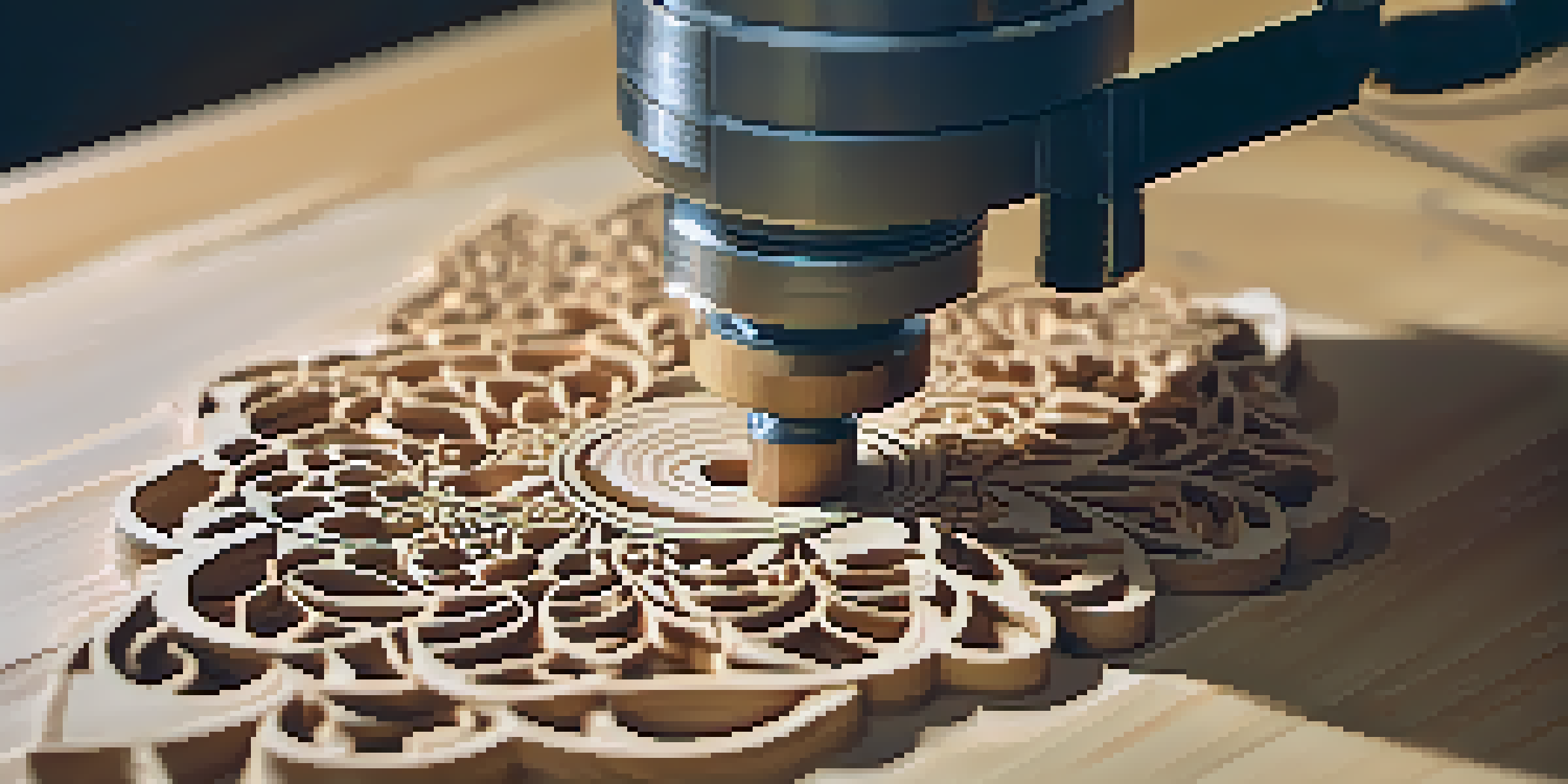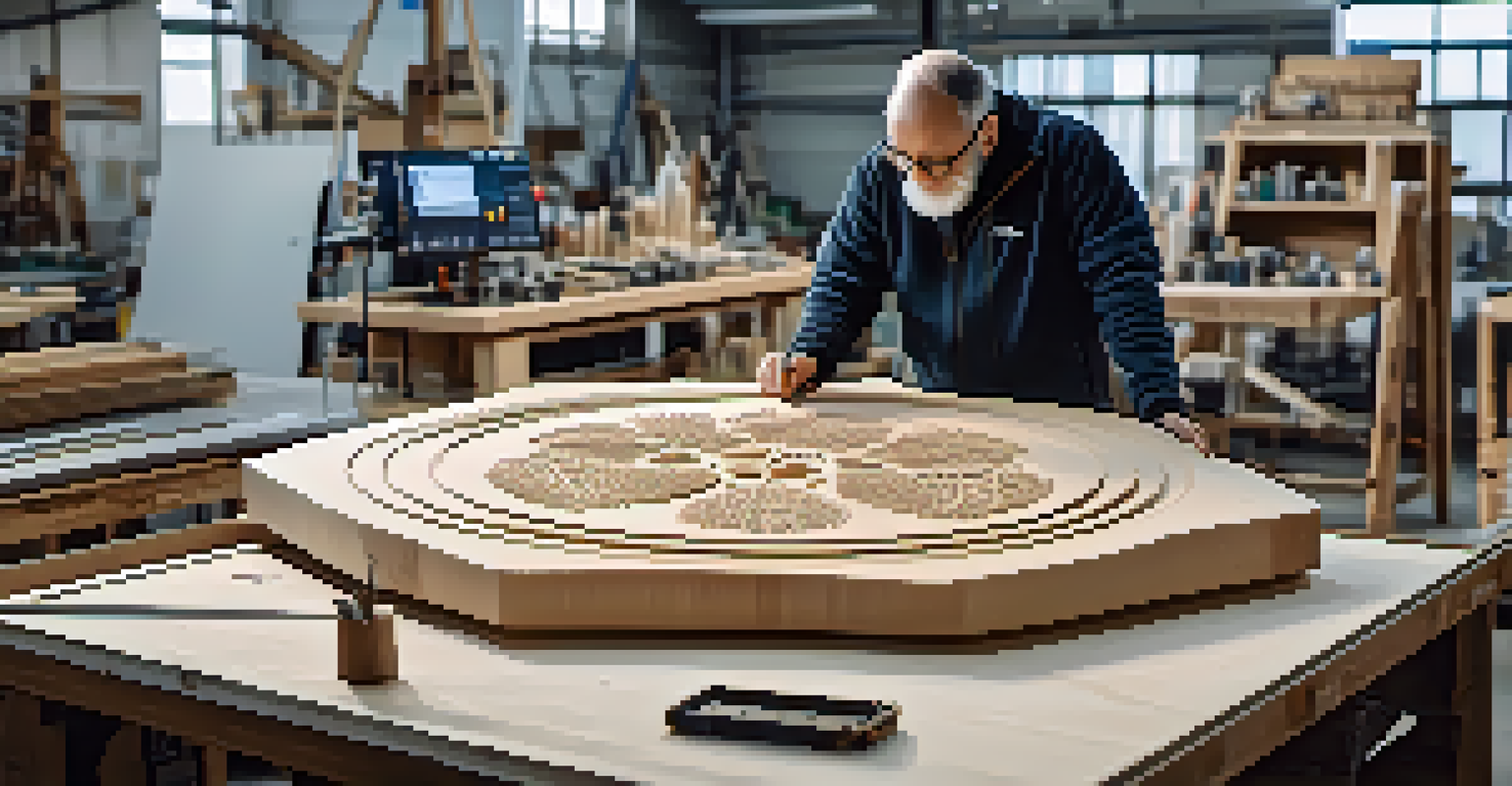CNC Carving: Bridging the Gap Between Art and Technology

Understanding CNC Carving: An Artistic Revolution
CNC carving stands for Computer Numerical Control carving, a process that automates the cutting and shaping of materials using computer software. Imagine a sculptor working alongside a precision machine, where creativity meets engineering. This technology allows artists to bring their visions to life with remarkable accuracy and detail, transforming raw materials into intricate designs.
Art is the most beautiful of all lies.
The beauty of CNC carving lies in its versatility; it can be applied to wood, plastic, metal, and even stone. This opens up a world of possibilities for artists and designers, enabling them to explore complex shapes and patterns that would be difficult or impossible to achieve manually. From delicate filigree to bold geometric forms, CNC carving offers a canvas where imagination knows no bounds.
By utilizing CNC machines, artists can replicate their designs with precision, ensuring consistency in their work. This capability is particularly beneficial for businesses that require multiple copies of a design, making it a practical solution for both artisans and manufacturers. Ultimately, CNC carving represents a harmonious blend of artistic expression and technological advancement.
The Process of CNC Carving: From Concept to Creation
The CNC carving process begins with an idea, which is transformed into a digital design using specialized software. Think of this stage as sketching a blueprint before constructing a building; it lays the foundation for the final product. The design is then translated into a language that the CNC machine understands, guiding it on how to cut, shape, and carve the material.

Once the design is ready, the artist selects the appropriate material and sets up the CNC machine. This setup includes securing the material, selecting the right tools, and inputting the design file. It’s like preparing your kitchen before cooking; having everything in place ensures a smoother process. With everything set, the machine begins to carve, following the digital instructions with incredible precision.
CNC Carving Merges Art and Tech
CNC carving blends artistic creativity with precision technology, enabling artists to create intricate designs across a variety of materials.
As the carving progresses, the artist can observe the transformation of the material, often feeling a mix of anticipation and excitement. The ability to see your vision come to life, layer by layer, is a unique experience that bridges the gap between art and technology. When the process is complete, what was once a simple block of material becomes a stunning piece of art.
Tools and Technologies: The Heart of CNC Carving
At the core of CNC carving is a variety of tools and technologies designed to achieve different results. For instance, routers, lasers, and mills each serve unique purposes, much like how a painter uses different brushes to create various effects. Understanding these tools allows artists to choose the right one for their specific project, enhancing their creative possibilities.
The best artist has no conception that a marble block does not contain within itself, but from his own imagination.
CNC routers are popular for wood carving, providing the ability to create intricate designs with fine detail. Lasers, on the other hand, offer precision cutting and engraving on a range of materials, including acrylic and metal. Each tool brings its own strengths, allowing artists to experiment and push the boundaries of their creativity.
In addition to the tools, the software used in CNC carving plays a crucial role in the process. Programs like VCarve or Fusion 360 help artists design, simulate, and prepare their projects for carving. This integration of software and hardware creates a seamless workflow, enabling artists to focus on their creativity while the technology handles the intricate details.
CNC Carving in Fine Art: A New Canvas
CNC carving has found its place in the realm of fine art, offering artists a new medium to explore. Many contemporary artists embrace this technology to create works that challenge traditional boundaries, merging sculpture, design, and technology. By incorporating CNC carving into their practice, these artists are not only expanding their toolkit but also redefining what art can be.
One fascinating aspect of CNC carving in fine art is the ability to create large-scale installations. Artists can design monumental pieces that are meticulously carved using CNC technology, enabling them to realize visions that would be nearly impossible to achieve by hand. This capability allows for impressive public artworks, engaging communities and sparking conversations around art and technology.
Versatile Applications in Industries
Beyond fine art, CNC carving is utilized in fields like architecture and furniture design, enhancing customization and production efficiency.
Moreover, CNC carving encourages collaboration among artists, engineers, and designers, fostering a unique environment where creativity flourishes. As artists continue to experiment with this technology, we can anticipate an exciting evolution in the art world, where innovation and imagination go hand in hand.
Applications of CNC Carving: Beyond Traditional Art
While CNC carving is often associated with fine art, its applications stretch far beyond that realm. Industries such as architecture, interior design, and product manufacturing have embraced CNC technology for its efficiency and precision. For instance, architects can create detailed models of their designs, allowing for better visualization before construction begins.
In the realm of furniture design, CNC carving enables artisans to craft unique pieces with intricate patterns and shapes. This technology allows for customization, catering to individual tastes and preferences while maintaining quality and consistency. Imagine having a custom coffee table that perfectly matches your living room decor, all thanks to the capabilities of CNC carving.
Additionally, CNC carving is making waves in educational settings, where students are learning to combine creativity with technology. Workshops and classes are introducing young minds to the possibilities of CNC machines, inspiring the next generation of artists and designers. By bridging the gap between traditional skills and modern technology, CNC carving is paving the way for innovative thinking.
Challenges and Considerations in CNC Carving
Like any technological advancement, CNC carving comes with its own set of challenges. One significant consideration is the initial investment required for the machines and software. While prices have decreased over time, acquiring a quality CNC machine can still be a barrier for some artists and small businesses, limiting their access to this innovative tool.
Moreover, mastering CNC carving requires a learning curve, as artists need to familiarize themselves with both the software and the machinery. This process can be time-consuming and may deter some individuals from exploring this medium. However, the rewards of overcoming these challenges often lead to enhanced creativity and new artistic possibilities.
Future of CNC Carving Looks Bright
With advancements in technology and a focus on sustainability, the future of CNC carving promises innovation and new creative opportunities for artists.
Lastly, there's an ongoing debate about the role of technology in art. Some purists argue that CNC carving takes away from the 'human touch' that traditional methods offer. Yet, many artists advocate for the idea that technology is simply another tool in the artist's toolbox, allowing for new forms of expression while still honoring the craftsmanship involved.
The Future of CNC Carving: Innovation on the Horizon
As technology continues to advance, the future of CNC carving looks promising. We can expect to see improvements in machine capabilities, software advancements, and even the integration of artificial intelligence. These innovations could further streamline the carving process, making it even more accessible to artists and designers.
Moreover, the rise of sustainable materials and eco-friendly practices could influence the direction of CNC carving. Artists are increasingly focusing on using responsibly sourced materials, which aligns with a growing awareness of environmental issues. This shift could lead to new creative avenues, where artists explore the intersection of art, technology, and sustainability.

Ultimately, CNC carving is poised to remain a vital part of the artistic landscape, bridging the gap between creativity and technology. As artists continue to push boundaries and explore new possibilities, we can anticipate an exciting future filled with innovation, collaboration, and stunning artistic creations.